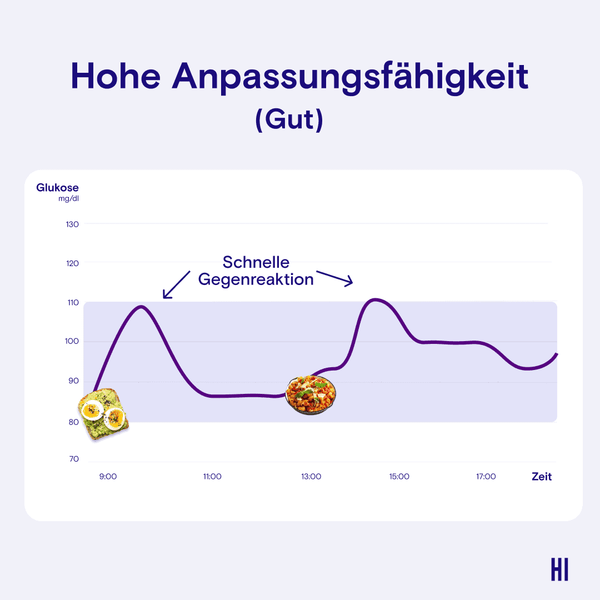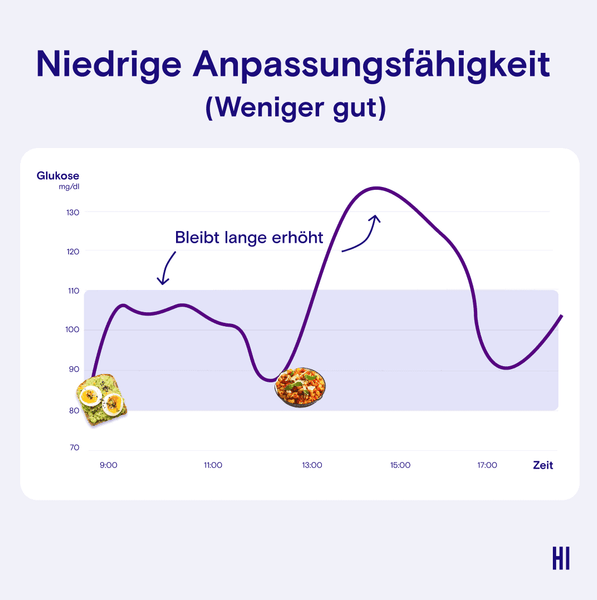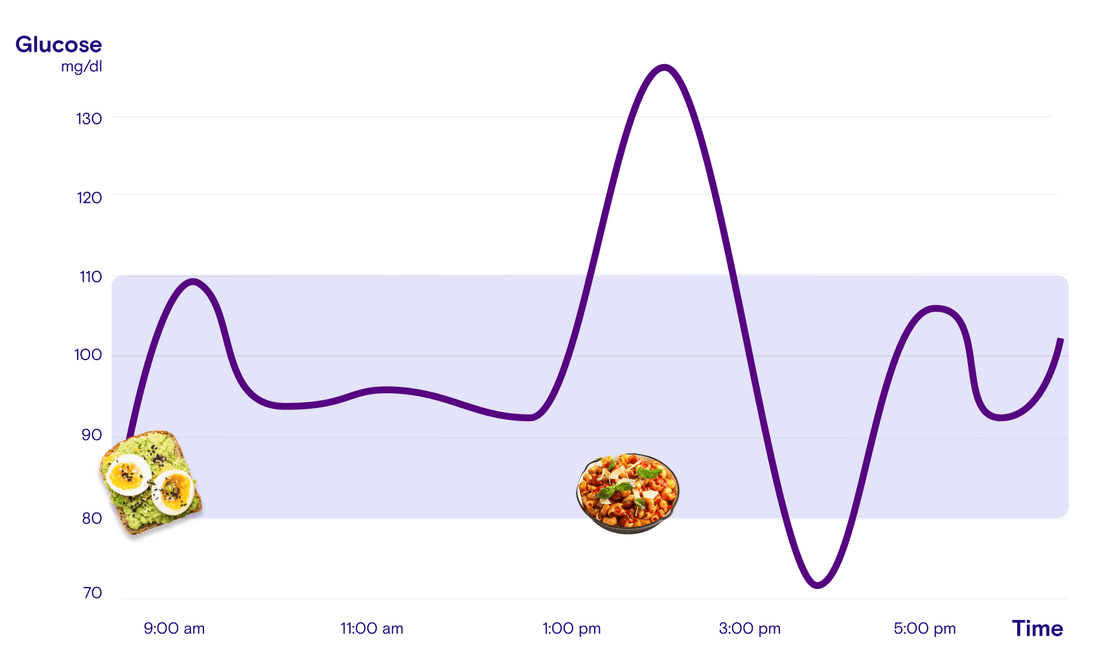Und warum sollte es dich interessieren?
Es ist normal, dass unser Blutzuckerspiegel im Laufe des Tages ein gewisses Auf und Ab hat.
Diese Schwankungen können auch von Tag zu Tag unterschiedlich sein. Essen, Bewegung, Stimmung, Stress und Schlaf können dazu führen, dass der Blutzuckerspiegel steigt und fällt.
Variabilität
Wir nennen dieses Auf und Ab des Blutzuckerspiegels im Laufe des Tages Variabilität.
Sie sind ein normaler Teil der Reaktionen unseres Körpers auf unser Leben. Von hoher Variabilität spricht man, wenn der Blutzuckerspiegel stark ansteigt und abfällt, sehr hoch und sehr niedrig. - Die klassische Blutzucker-Achterbahn
Vielleicht hast du zum Mittagessen eine große Portion Nudeln gegessen. Dein Blutzucker steigt steil an, und für etwa eine halbe Stunde fühlst du dich großartig, voller Energie und gut gelaunt. Aber bald ist diese Energie aufgebraucht. Du kannst dich nicht mehr konzentrieren, und du brauchst unbedingt etwas zu essen; und zwar jetzt.
Wenn du so etwas mehrmals am Tag erlebst, schwankt Ihr Blutzucker stark, was eine hohe Variabilität bedeutet. Du befindest dich auf einer Blutzucker-Achterbahn. Diese ständige Achterbahnfahrt von Hochs und Tiefs kann dazu führen, dass du erschöpft, launisch und hungrig bist.


Anpassungsfähigkeit
Neben der Variabilität (wie stark der Blutzuckerspiegel steigt und fällt) geht es auch um die Anpassungsfähigkeit (wie lange der Blutzuckerspiegel erhöht bleibt, bevor er wieder auf den Ausgangswert zurückgeht).
Wenn dein Körper einem Anstieg des Blutzuckerspiegels schnell entgegenwirkt und es schafft, die Werte stabil zu halten, hast du eine hohe Anpassungsfähigkeit. Ein Blutzuckerspiegel, der nicht innerhalb von 2,5 Stunden nach dem Essen wieder sinkt, ist ein Zeichen für eine schlechte Anpassungsfähigkeit


Die Gute Nachricht:
The good news:
Du kannst deinen Blutzuckerspiegel mit ein paar einfachen Änderungen deines Lebensstils stabilisieren, so dass es leichter wird, im optimalen Bereich von 80-110 mg/dl (140 mg/dl nach dem Essen) zu bleiben.
Tips um deine Variabilität und Anpassungsfähigkeit zu verbessern:
Achte auf deine Ernährung
Vor einer schlechten Ernährung kann man nicht davonlaufen. Selbst bei regelmäßiger Bewegung belasten ungesunde Lebensmittel deinen Körper auf zellulärer Ebene. Konzentriere dich auf Vollwertkost mit vielen Ballaststoffen und vermeide stark verarbeitete Lebensmittel und zugesetzten Zucker.
Idealerweise isst du die Ballaststoffe zuerst, wann immer es möglich ist.
Bewegen dich regelmäßig
Bewegung hat viele positive Auswirkungen, wie z. B. eine bessere Kontrolle des Blutzuckerspiegels und eine verbesserte Insulinempfindlichkeit. Die Verbesserung der Insulinempfindlichkeit führt zu einer besseren Variabilität und Anpassungsfähigkeit. Außerdem hilft sie deinem Körper, einen gesunden Blutzuckerspiegel aufrechtzuerhalten.
Betreibe unterschiedliche Sportarten, da du deinen Körper dabei unterstützt, metabolisch flexibler zu werden.
Reduziere Stress und sorge für ausreichend Schlaf
Zu viel Stress und zu wenig Schlaf können zu chronischen Gesundheitsproblemen wie Diabetes führen oder das Risiko für Herz-Kreislauf-Erkrankungen erhöhen.
Schlechter Schlaf kann sich auf den Hormonhaushalt auswirken und Entzündungen in deinem Körper verstärken. Stress führt dazu, dass der Körper Hormone wie Adrenalin und Cortisol ausschüttet. Bei einer "Kampf-oder-Flucht"-Stressreaktion schüttet unser Körper Glukose aus, um die für die Bewältigung der Situation erforderliche zusätzliche Energie bereitzustellen.
Stressabbau und verbesserter Schlaf können eine gesunde Glukoseregulierung unterstützen und sich positiv auf die Variabilität und Anpassungsfähigkeit auswirken.





